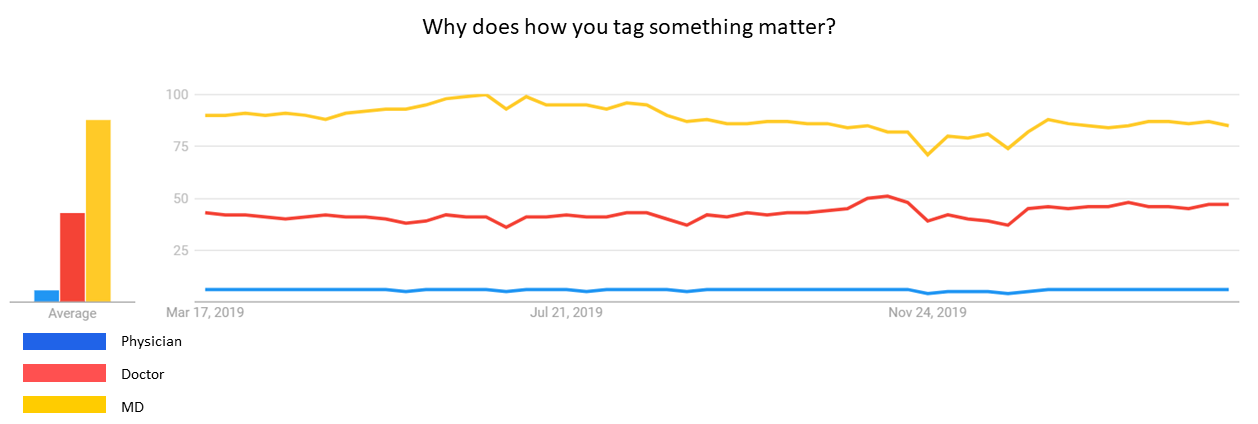In a world of sophisticated search engines and machine learning (ML), it might seem like investing in a taxonomy is overkill. After all, can’t those ML-enabled search engines find everything?
Sometimes even technology needs an assist.
Let’s look at why you might want a taxonomy.
What Taxonomies Are Good For
Taxonomies enable three main digital functions: findability, faceted search, and personalization. Let’s take a look at each.
Findability – The User First
If your website has any breadth and depth of content, many users are going to conduct a site search rather than browse for what they are looking for. Research has shown that 50% of users go directly to search on a website. And while site searches are getting increasingly powerful, they can’t find what isn’t there.
For example, consider the user searching for “physician” on a medical website. This website is untouched by any taxonomy. The user gets a bunch of search results for “physician,” and maybe what they need is in the top few results, but entries that have “doctor,” “MD,” or “DO,” but not “physician,” won’t show up. What is the user missing?
By tagging all relevant documents with “physician” and having a robust search engine map that can account for misspellings and mistyping, the user sees a complete list of all physician-related documents.
Alternatively, assuming your search engine is sophisticated enough, you can create a map of terms to surface everything with the word “doctor” in a search for “physician.”
What’s next? So, the user now has a long list of all physician-related pages and documents… but it is long. An estimated 91% of users don’t look past the first page of search results, and more than 50% don’t look past the first three results. If the specific desired results don’t float to the top, it’s potentially a huge miss. How can you make sure the most useful information floats to the top?
- Don’t over-tag the content.
- Use type-ahead suggestions to help focus the user’s search.
- Weight results to drive the most useful content up in the results.
- Create a robust “see also” experience, so users narrow their searches with predictive search.
- Provide a list of “did you mean?” suggestions in the search results to focus the user’s search.
Each of these is enabled by a good taxonomy.

This is a Google Trends chart showing the relative search interest for three terms over the course of a year. “100” is maximum interest; all other points are relative to that. In this comparison, “MD” has the highest interest; “physician” has low interest. But a good taxonomy would ensure that whether the user searches for “physician,” or “doctor,” or “MD,” they would get appropriate results.
Findability – Authors Count, Too
A secondary use for a good taxonomy is to allow users to identify content instances in the content management system (CMS) for updating and sunsetting. Topical taxonomies – the most common user-facing taxonomy – are useful here, but even more so is a content type taxonomy. A content type taxonomy includes tagging content instances with content type, date of creation, date it should be reviewed, author, and owner (among other tags).
This will help content authors to identify content in the CMS and manage it effectively and efficiently.
Faceted Search
Faceted search is the fancy term for structured search. All those places where you can search for doctors by their specialty or location – faceted search. When you can search a dataset of events by date and topic – faceted search.
If you don’t have specific tags to support structured search, the results will be unreliable. For example, “boxing class” won’t show up under a “fitness class” filter.
Faceted search categories and terms are usually set up as part of the searching/filtering tool. The content type (such as “events”) have specific categories (such as “date,” “location,” and “topic”) from which the author has to choose terms (such as “fitness class”). You might not view this as part of your taxonomy, but it is.
Product Search: Faceted Search to Drive Sales
Product search is a special type of faceted search. Customers trying to identify the right product for them often need to filter based on multiple criteria. What size cups do I want? How many rolls of toilet paper can I store? How big is the bookshelf I like? Supporting rich tagging of products, tied to user needs and the customer journey, is key to creating a strong experience that can drive sales.

High-end carpet manufacturer Karastan allows filtering by multiple facets, including style preferences, such as “Animal Prints,” because sometimes specifying “green” doesn’t get the user close enough to their dream carpet.
As with most taxonomies, the trick is to support tagging that both groups and separates products. The products should be grouped into meaningful categories that are specific enough so they also adequately separate and differentiate the products.
Personalization
A good taxonomy also enables personalization. If you are trying to message your users differently based on user attributes or behavior (for example, the type of user, past experience with your organization, or recent behavior on the site), different messages need to be identified in some way.
For example, you lead marketing for an association. The entry point to membership and fee-based continuing education courses is an initial certification course. When a user first visits the website, you may surface messaging that encourages purchasing the certification course. Once that is completed, you may want subsequent messaging to encourage membership and its professional networking and growth benefits. Once they become a member, you might want to encourage purchase of advanced continuing education courses, conference attendance, or premier networking events. As the user’s engagement grows, the messaging changes.
Organizational Role Personalization
Another common type of personalization is based on organizational roles, which is commonly seen in intranets. Based on job titles, organizational levels, locations, or departments, internal users of intranets may see a slightly different “view” of the corporate intranet. They’ll see events specific to their location, training appropriate for their role, or announcements appropriate only for their level of management. This makes their intranet experience more relevant and effective for each employee.
Each of these types of personalization require that content instances be dynamically surfaced to users. To do so, content instances (a promotion, an event, an announcement) need to be tagged with terms that correspond to the attributes driving the personalization. That’s a taxonomy, too.
Can Machine Learning Help?
Machine learning can make a huge difference in making a taxonomy part of your user experience. Some of the ways ML can help include:
- Identification of clusters of terms to inform the development of the taxonomy
- Automatic assignment of taxonomical terms based on an analysis of the content
- Application of learnings over time to identify and refine customer paths through the content
Other important inputs into taxonomy development are search term analysis, domain modeling, and user language research.
First Steps
Before you think about a taxonomy, think about what you want your user experience to be. If you have only one or two products, you probably don’t need a faceted search. If your website is only five pages encouraging users to call the organization, you probably don’t have to consider too much about search.
But if you have a site of any depth, robust content, or users with different goals, ask yourself these questions:
- Will my users feel better about the organization, the products and services, and their experience if they find exactly the right information easily? 75% of consumers admit to making judgments on a company’s credibility based on the company’s website design.
- How will that impact engagement and ROI? McKinsey found that companies placing data-driven personalization at the core of marketing and sales decisions improve marketing ROI by 15-20%.
A strong taxonomy can help.


Thanks for this amazing article. I generally read your articles with a lot of enthusiasm because of its content. Also, recently I have also written on the same niche could your please share your views on it here: AI In Web Development